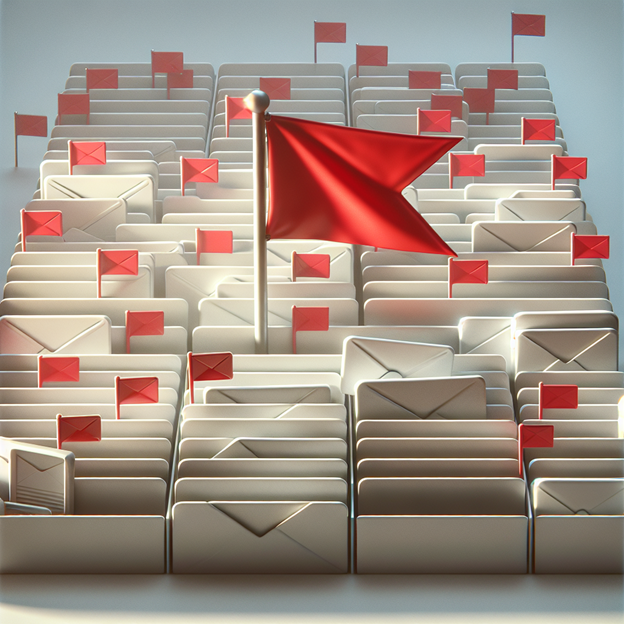
Flagging Emails: Understanding the Basics and Best Practices
Emails are one of the most out-of-control digital trashstorms on this side of social media/ In the hyper-speed world we live in today, keeping your email inbox clean can be an unbelievable task. Important communications are easy to miss when there is a tide of messages.
Flags are great for making your email managing skills even more centralized. This blog unpacks the concept of flagging emails, reveals tips for dealing with them, and shares an email template that will make you more productive.
Flag, Flag an Email, Flagged Email Mean, Email Templates
What are Email Flags, and Why You Should Use One to Manage Your Time Understanding what a flagged email is and does, can help you to become further efficient in managing your emails. This is represented by flags, as a visual cue to tell you that an email is either important or it needs your action sometime later.
Understanding Email Flags
Surprise will improve your productivity with email flags. A Message Flag will act as a reminder or to highlight the importance. After all a flagged email may require an action from you or are waiting for justification for action request (IJAR). Right-click on an item to flag it as complete when finished. It is a good thing that essential emails remain in front of you, as it prioritizes email in such an orderly way instead of wasting most of your time by managing this kind of mail.
The other thing is that you need to check those flagged emails regularly for this information, or it will just end up becoming one big list of unread emails. Once you do flag an email, make a little routine out of checking on those flagged emails to see if their deadlines are approaching. You can also tag your emails as important as such. Making CESA 10 IMPORTANT If you are getting multiple emails that say important from me in the subject, when time allows respond to those and this will keep us both a bit more organized.
What Is the Significance of Flagging an Email?
It saves that email to your new folder (might even say flagging an item), it is like dog-eating a page in the book. This process includes marking an email with a flag icon that signifies its importance or reminds you when you need to follow up. Many people rely on flagged messages to keep their inboxes in check.
Types of Flags and Their Uses
Flagged emails can be set in many ways, often color-coded to indicate different levels of urgency. A red flag could remind you of an urgent task, while a yellow flag might prompt you to follow up later on. By flagging, you can turn a cluttered inbox into an organized ‘to-do’ list!
Benefits of Using Email Flags
Flags are also a way of marking certain emails to be the top priority among the sea of emails. This kind of prioritization helps you clear up your inbox and first sort out emails that demand an immediate response. Bring these tools into the team environment, and you unlock a wealth of organization and productivity.

Best Practices for Email Flagging
By using these email flagging best practices, you can ensure your emails are easily managed and remain productive. Implement a visible flag system for more organized types of messages: Highlight flags designed to indicate important emails and urgent flags that demand immediate attention. In this manner, you can easily differentiate high-importance messages that may get lost in the midst.
This way, when you flag emails for follow-up, include notes to remind yourself what it represents. This will remind you what the issue was and they need to be dealt with (I do!). The secret to being productive isn’t having your inbox empty, but it is yours with flagged emails well organized and access them easily when they are needed. Pay attention to some of these steps you can do automatically (based on the subject line or sender) creating a rule to start clean in an automated way.
Consistency in Flag Usage
One of the most important things is that you use flags in your email client consistently. Having a standardized system provides instant visibility into the flagged emails and reminders of what needs attention. You can jot notes down as you scrap the project, and this helps in keeping everything neat and streamlining communication.
Consistent Evaluation of Marked Emails
Examine them regularly to ensure flagged emails do not pile up. Schedule in time to review flagged messages, unflag the ones that are no longer relevant, and then follow up when needed. This ensures that we keep a good flow going throughout the day and nothing gets missed.
Integrating Email Templates with Flags
With the use of Power Automate, Email templates can come in handy in managing flagged emails. Building templates for specific flagged responses can help expedite your response and save you time. This integration offers you a way to manage repetitive tasks easily and affects your general effectiveness.

Different Types of Flagged Emails
In email land, flagged emails can be a game changer for productivity and organization. Flagged Email: A flagged email is an email that has been marked for attention, making it easier to manage the flagged messages by users.
For example, you could use a red flag for an all-hands-on-deck this is a critical type of message and assign other types with yellow flags. They are used to alert the receiver of an email that they need to take some action or important note inside.
When the task is done, you can just unflag it in a desktop application or on any web-based service. This keeps your folder clean and not so messy. This way, the recipient will understand that you consider your message to be urgent and it is important for them to approach reading your electronic letter/conversation conscientiously.
Therefore, flagged emails can help to optimize processes and make sure that no required tasks remain unperformed once you execute them.
How to Flag Emails in Different Platforms
Flagged emails are a valuable tool for managing your inbox efficiently. By using this feature, you can organize your emails and highlight messages that matter to you. Each platform offers different ways to flag emails; for instance, in some applications, you can simply press enter after selecting an email to turn it yellow. This helps you locate them later and ensure you’re on top of follow-up tasks.
It’s important to remember that flagged emails can signify due dates or start dates, allowing you to prioritize less urgent matters while keeping you on track. Depending on the platform, flagged emails may appear in different places, ensuring you can access the email directly when needed. This way, you can focus on getting things done without losing sight of the tasks that require your attention.
Flagging an Email in Outlook
How to Flag Emails in Outlook Flags is easy, just follow these steps. Click the flag icon to the right of an email in order to follow up. You can also set a start date and due date for tasks related to the flagged emails which turns into Outlook task management.
Marking an Email in Gmail
Gmail: If you want to flag it, mine for some important markers. Manually tap a star to flag an important email so that you can access it later. You are also able to utilize color-coded stars in Gmail, this can help you put flags into groups easily.
Removing Flags from Emails
Unflagging emails is a must when you have completed the required work. Luckily, nearly all email clients (Outlook and Gmail prominently among them) provide easy ways to unflag messages so your list of currently flagged items stays up-to-date.

Handling Flagged Emails
Flagged Messages and Their Recipients
You were only able to flag an email, which helps you and may serve as a signal that you will be trying again with the recipient. These visual aids can assist in communication, making sure everyone is on the same page regarding follow-up.
Sender’s Perspective on Flagged Emails
Senders should know how flagged emails look like to the recipient which can have a significant impact on your Email strategy. Flagging highlights the importance behind an email, this ideally drives for a faster response compared to all other messages.
Conclusion
Flagging emails is a great way to keep an organized inbox. Knowing the nooks and crannies of various email Clients, and adhering to best practices not only ensures that any important email also receives a decent amount of attention. Whether it be to manage your tasks, prioritize communication, or even serve as a complement to email templates this tool is made intelligently and efficiently to boost your productivity related to emails.
FAQs
What is the purpose of flagging an email?
It makes email flags stand out easier and hence become locatable for follow-ups which preempts and enhances the efficiency of email management.
Is flagging an email good or bad?
Flagged emails are crucial to help you get your work done and not leave anything behind. They remind you of crucial aspects directly from your inbox, which helps in actual prioritization.
With the traditional flag, you can bucket the tasks based on start and end dates thereby marking your flagged emails to be processed. Where this changes for you as the user is that flagged emails turn yellow to indicate a higher level of importance, allowing you to focus on different things given priority.
How can I flag an email in Gmail?
You can add important labels or star markings to emails in Gmail which will make the marked email show up on top.
Can flagged emails be automatically unflagged?
Your email client may also give you choices for when to automatically unflag emails, allowing your inbox to head directly into the promised land of zero.
Why is consistency important in flagging emails?
Regularly flagging emails for follow-up helps to keep everything in order and ensures that no important correspondence slips between the cracks or goes unanswered.
Are there any tools to help manage flagged emails?
A lot of email clients also provide built-in tools alongside third-party applications to organize flagged and high-importance emails in a way that nothing important is left out.

Hi! I’m Muhammad Shahzaib. As a content writer focused on technology, I constantly seek out trending topics to deliver fresh, insightful articles. My goal is to keep readers informed and engaged with the latest and emerging innovations in the tech world.